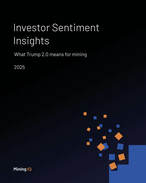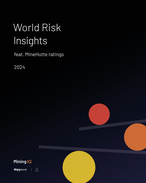This article is 7 years old. Images might not display.
Should consensus commodity prices be used? How much of a discount should be applied to a project in Afghanistan? Should an investor even consider putting money into a company using unproven industry technology?
All of the answers vary depending on which analyst you speak with. Some are more conservative, while others are convinced they have the inside track and, therefore, are much more bullish.
When Mining Journal and Mining Journal Intelligence came up with the Mining Journal Intelligence database - a list of the undeveloped projects in the pipeline that deserve to be financed and should, in theory, be built - these poles of thought were taken into account.
After scouring through the portfolios of over 2,000 listed entities to arrive at a database full of the ‘quality' projects in the undeveloped pipeline, we have spotted quite a few common economic trends.

Executives from thirty of the projects that made it onto the Mining Journal Intelligence database will be highlighting these ‘quality' trends and others to a highly-qualified audience of the most influential institutions, private and family investors on June 26-27 in London at the Mining Journal Select event.
But, before that, here's a few pointers.
Quantitative and qualitative
Spot commodity prices are a good place to start when valuing a project, according to Chris Hinde of S&P Global Market Intelligence.
"You can't really be criticised for taking the current price," he told Mining Journal.
Hinde, who will be quizzing Sprott's Rick Rule on stage at the Mining Journal Select event, said companies set their exploration budgets by these numbers and the ebb and flow of financings are often dictated by the spot price direction.
Yet, a range of commodity prices should also be analysed. If we've learnt anything from the last downturn, it is that projects need as much downside protection as upside potential.
The companies on the project database tend to present such sensitivities upfront in economic studies, allowing investors to factor in both.
Identical projects in different countries have different values
We've talked about management before when it comes to valuing projects - the right type deserving a higher value - but the amount of shares the executive team hold in a company is also a key indicator.
It's an obvious point, but the more invested the c-suite are, the more motivated they will be to make a success of it.
Then, jurisdictions should also be considered.
As Hinde said: "Identical projects in different countries have different values."
There is nothing contentious in saying a 100,000 ounce per annum gold project with an all-in sustaining cost of US$800 per ounce in Quebec, Canada, should be valued differently to a project with the same production profile and capital cost in Eritrea.
Saying that, if the management team has, in the past, successfully financed and developed a 100,000ozpa gold project 3km down the road, the valuation between the two might not be all that different.
Engineering risk is also another consideration - predictability being important here.
If a company has replicated a flowsheet from an existing mine in its feasibility study, one that is operating successfully under similar constraints and conditions, that derisked element should be reflected in a project's valuation.
Making bold calls on promising but unproven technology should also be accounted for in the investment case.
These are but a few considerations worth highlighting when considering what makes a project ‘quality'.
Carrying out such due dilligence allows investors to spot where there is potential upside in the current market valuation.
For instance, if a copper project in North America that is two years away from development and being run by a management team that has explored for, permitted and constructed a similar size mine in the same jurisdiction is being valued at the equivalent of a $5,000 per tonne red metal price, it may be worth a second look.
Investors also have to be ready to react, with the recent change of power in South Africa, for example, potentially leading to a very different operating environment for miners.
One would expect share prices to react to this. If they don't, unless there is a more obvious reason for no value appreciation, it could signal an investment opportunity.
Just as important as these ‘upside' opportunities are the ‘downside' risks.
Political changes can be both positive and negative for the investment case, and there are occasions where a company's value far exceeds any rational return expectation.
This is why the Mining Journal Intelligence database is fluid - projects will go in and out depending on changing circumstances.
Investors have to consider this with their own portfolios.
To find out more about the Mining Journal Intelligence Database or the Mining Journal Select event, please contact Dan Gleeson.
The dedicated Mining Journal Select event website is available here.

























